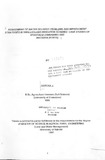| dc.description.abstract | The potential benefits from smallholder irrigation schemes are rarely realised due to
unsatisfactory performance of their water delivery systems. This study aims at evaluating and
identifying strategies for improving the performance of water delivery systems of two contrasting
smallholder irrigation schemes. At Nyanyadzi pump (and gravity) fed scheme in Zimbabwe with
an integrated organisational structure and lined delivery system, the study entailed evaluating
water delivery performance objectives of adequacy (Ad), reliability (Dp) and water distribution
equity (Eq), using a close ended questionnaire survey and water requirement and problem
analyses in block A. Poor adequacy, equity and reliability of water supply were perceived
respectively by 57 %, 53 % and 77 % of the 30 irrigators interviewed in block A. At least 60 %
of the respondents attributed this poor performance to illegal abstractions, weedy and silted
conveyance canals. Solutions asserted by 90% of respondents were dam construction and
increased pumping capacity at supply rivers.
Water delivery performance indicators (Ad, D, and Eq) were quantified in block A, between
October 1996 and January 1997 in two irrigation rotation turns. Good adequacy in the first turn
and poor adequacy in the second were attained, but adequacy was negatively correlated (R2 =
0.89) to the irrigation requirement on a particular irrigation date. Similar inferences were
obtained for adequacy quantified as the weekly relative water supply (RWS).
In the same block, equity was quantified spatially and found to be poor during the period
considered. On the other hand the reliability of water supply to this block was assessed
temporally at 42 locations and 73 % had poor reliability. Furthermore, problem analysis revealed
that the major causes of the unsatisfactory water delivery were inadequate water resource,
inadequate flow regulation and deferred maintenance at the scheme.
At the Matanya gravity-fed segregated and unlined scheme in Kenya, the study involved the
delineation of the water delivery system and assessment of irrigation water supply and demand.
A questionnaire survey was employed to establish the inigation water demand and to augment
flow measurements in main canal for supply assessment. The results show that on average, 4.5
times the legalised amounts of water were diverted to the scheme 75 % of the time (in the wet
IV
seasons) compared to 0.64 proportion in the dry seasons. Water shortages resulted from
inadequate regulation and losses through seepage, overtopping and consumptive use by the
weeds. This was worsened by unscheduled abstraction from main canals through the use of
channels with no design specifications.
It was concluded that the performance of the water delivery systems of smallholder schemes
were related to their management (operation & maintenance ) and inherent to design defects,
regardless of the relative amounts conveyed, the irrigation infrastructure, organisational structure
and the ownership of the irrigated land. The strategies for improving the performance of water
delivery systems of these schemes identified were: maxmising use/storage of delivered irrigation
water; installation of water control structures at strategic points along the delivery system
network; adequate maintenance of the system; routine monitoring and evaluation of the delivery
system; training of water users and water masters on aspects of irrigation operation and
introduction of rules and staffing for improved performance of delivery system.
v | en |

